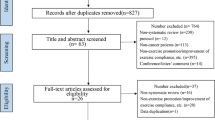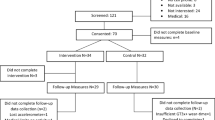Abstract
Purpose
Physical activity is known to minimize the long-term side effects of cancer treatment. Yet, rates of physical activity participation by cancer survivors are significantly lower compared to the general population. The purpose of this pilot study was to examine the efficacy, feasibility, and acceptability of a technology-based intervention to promote maintenance of physical activity after completing an exercise-based oncology rehabilitation program.
Methods
The pre-post 4-week intervention included support delivered through tailored text messages, Fitbit® self-monitoring, and brief health coaching sessions. The primary outcome measure was accelerometer-assessed physical activity levels. Self-efficacy, self-regulation, social support, fatigue, sleep disturbance, depression, and Fitbit® step counts were assessed as secondary outcomes.
Results
Twenty-four participants (20 females; mean age = 57.9 years ± 10.4) completed the intervention. Mean daily step counts and weekly minutes of moderate-to-vigorous intensity physical activity were maintained after the intervention, as compared to baseline levels achieved at the end of 12 weeks of exercise-based oncology rehabilitation. Both self-regulation (goal setting, relapse prevention) and fatigue severity increased significantly post intervention as compared to baseline (p = 0.05 and p = 0.02, respectively). Qualitative responses demonstrated overall satisfaction with intervention components.
Conclusions
Results demonstrate efficacy of the intervention for maintenance of physical activity levels achieved during exercise-based oncology rehabilitation. Low attrition and high satisfaction provide evidence for both the acceptability and feasibility of the intervention components. Exercise interventions post oncology treatment provide multiple benefits for cancer survivors, yet continued maintenance after program completion is challenging. Technological options offer low-cost, accessible modes to deliver continued monitoring and support beyond traditional facility-based programs.




Similar content being viewed by others
References
Centers for Disease Control and Prevention (CDC) (2004) Cancer survivorship—United States, 1971-2001. MMWR Morb Mortal Wkly Rep 53:526–529
Miller KD, Siegel RL, Lin CC, Mariotto AB, Kramer JL, Rowland JH, Stein KD, Alteri R, Jemal A (2016) Cancer treatment and survivorship statistics, 2016. CA Cancer J Clin 66:271–289. doi:10.3322/caac.21349
Leach CR, Weaver KE, Aziz NM, Alfano CM, Bellizzi KM, Kent EE, Forsythe LP, Rowland JH (2015) The complex health profile of long-term cancer survivors: prevalence and predictors of comorbid conditions. J Cancer Surviv 9:239–251
Wurz A, St-Aubin A, Brunet J (2015) Breast cancer survivors’ barriers and motives for participating in a group-based physical activity program offered in the community. Support Care Cancer 23:2407–2416. doi:10.1007/s00520-014-2596-2
McNeely ML (2006) Effects of exercise on breast cancer patients and survivors: a systematic review and meta-analysis. Can Med Assoc J 175:34–41. doi:10.1503/cmaj.051073
Courneya KS (2003) Randomized controlled trial of exercise training in postmenopausal breast cancer survivors: cardiopulmonary and quality of life outcomes. J Clin Oncol 21:1660–1668. doi:10.1200/JCO.2003.04.093
Committee PAGA, others (2008) Physical activity guidelines advisory committee report, 2008. Wash DC US Dep Health Hum Serv 2008:A1–H14
Buffart LM, Thong MSY, Schep G, Chinapaw MJM, Brug J, van de Poll-Franse LV (2012) Self-reported physical activity: its correlates and relationship with health-related quality of life in a large cohort of colorectal cancer survivors. PLoS One 7:e36164. doi:10.1371/journal.pone.0036164
Vallance JK, Boyle T, Courneya KS, Lynch BM (2014) Associations of objectively assessed physical activity and sedentary time with health-related quality of life among colon cancer survivors. Cancer 120:2919–2926. doi:10.1002/cncr.28779
Li T, Wei S, Shi Y, Pang S, Qin Q, Yin J, Deng Y, Chen Q, Wei S, Nie S, Liu L (2015) The dose–response effect of physical activity on cancer mortality: findings from 71 prospective cohort studies. Br J Sports Med. doi:10.1136/bjsports-2015-094927
Smith W, Nolan V, Robison L, Hudson M, Ness K (2011) Physical activity among cancer survivors and those with no history of cancer—a report from the National Health and Nutrition Examination Survey 2003-2006. Am J Transl Res 3:342–350
Hong S (2007) Correlates of physical activity level in breast cancer survivors participating in the Women’s Healthy Eating and Living (WHEL) Study. Breast Cancer Res Treat 225–232
Loprinzi PD, Cardinal BJ, Si Q, Bennett JA, Winters-Stone KM (2012) Theory-based predictors of follow-up exercise behavior after a supervised exercise intervention in older breast cancer survivors. Support Care Cancer 20:2511–2521. doi:10.1007/s00520-011-1360-0
Dittus KL, Lakoski SG, Savage PD, Kokinda N, Toth M, Stevens D, Woods K, O’ Brien P, Ades PA (2015) Exercise-based oncology rehabilitation: leveraging the cardiac rehabilitation model. J Cardiopulm Rehabil Prev 35:130–139. doi:10.1097/HCR.0000000000000091
Haas BK, Kimmel G, Hermanns M, Deal B (2012) Community-based FitSTEPS for life exercise program for persons with cancer: 5-year evaluation. J Oncol Pract 8:320–324. doi:10.1200/JOP.2012.000555
Cheifetz O, Dorsay JP, MacDermid JC (2015) Exercise facilitators and barriers following participation in a community-based exercise and education program for cancer survivors. J Exerc Rehabil 11:20–29. doi:10.12965/jer.150183
Trost SG, McIver KL, Pate RR (2005) Conducting accelerometer-based activity assessments in field-based research. Med Sci Sports Exerc 37:S531
Sasaki JE, John D, Freedson PS (2011) Validation and comparison of ActiGraph activity monitors. J Sci Med Sport 14:411–416. doi:10.1016/j.jsams.2011.04.003
Ferguson T, Rowlands AV, Olds T, Maher C (2015) The validity of consumer-level, activity monitors in healthy adults worn in free-living conditions: a cross-sectional study. Int J Behav Nutr Phys Act. doi:10.1186/s12966-015-0201-9
Paul SS, Tiedemann A, Hassett LM, Ramsay E, Kirkham C, Chagpar S, Sherrington C (2015) Validity of the Fitbit activity tracker for measuring steps in community-dwelling older adults. BMJ Open Sport Exerc Med 1:e000013. doi:10.1136/bmjsem-2015-000013
Sallis JF, Pinski RB, Grossman RM, Patterson TL, Nader PR (1988) The development of self-efficacy scales for healthrelated diet and exercise behaviors. Health Educ Res 3:283–292. doi:10.1093/her/3.3.283
Umstattd MR, Motl R, Wilcox S, Saunders R, Watford M (2009) Measuring physical activity self-regulation strategies in older adults. J Phys Act Health 6(Suppl 1):S105–S112
Sallis JF, Grossman RM, Pinski RB, Patterson TL, Nader PR (1987) The development of scales to measure social support for diet and exercise behaviors. Prev Med 16:825–836
Kroenke K, Spitzer RL (2002) The PHQ-9: a new depression diagnostic and severity measure. Psychiatr Ann 32:509–515. doi:10.3928/0048-5713-20020901-06
Martin A, Rief W, Klaiberg A, Braehler E (2006) Validity of the brief patient health questionnaire mood scale (PHQ-9) in the general population. Gen Hosp Psychiatry 28:71–77
Löwe B, Kroenke K, Herzog W, Gräfe K (2004) Measuring depression outcome with a brief self-report instrument: sensitivity to change of the Patient Health Questionnaire (PHQ-9). J Affect Disord 81:61–66
Garrett K, Dhruva A, Koetters T, West C, Paul SM, Dunn LB, Aouizerat BE, Cooper BA, Dodd M, Lee K, Wara W, Swift P, Miaskowski C (2011) Differences in sleep disturbance and fatigue between patients with breast and prostate cancer at the initiation of radiation therapy. J Pain Symptom Manag 42:239–250. doi:10.1016/j.jpainsymman.2010.11.010
Van Onselen C, Cooper BA, Lee K, Dunn L, Aouizerat BE, West C, Dodd M, Paul S, Miaskowski C (2012) Identification of distinct subgroups of breast cancer patients based on self-reported changes in sleep disturbance. Support Care Cancer 20:2611–2619
Hann DM, Jacobsen PB, Azzarello LM, Martin SC, Curran SL, Fields KK, Greenberg H, Lyman G (1998) Measurement of fatigue in cancer patients: development and validation of the Fatigue Symptom Inventory. Qual Life Res 7:301–310
Hann DM, Denniston MM, Baker F (2000) Measurement of fatigue in cancer patients: further validation of the Fatigue Symptom Inventory. Qual Life Res 9:847–854
Donovan KA, Jacobsen PB, Small BJ, Munster PN, Andrykowski MA (2008) Identifying clinically meaningful fatigue with the Fatigue Symptom Inventory. J Pain Symptom Manag 36:480–487. doi:10.1016/j.jpainsymman.2007.11.013
Donovan KA, Jacobsen PB (2011) The Fatigue Symptom Inventory: a systematic review of its psychometric properties. Support Care Cancer 19:169–185. doi:10.1007/s00520-010-0989-4
Spark LC, Reeves MM, Fjeldsoe BS, Eakin EG (2013) Physical activity and/or dietary interventions in breast cancer survivors: a systematic review of the maintenance of outcomes. J Cancer Surviv 7:74–82
Beauchamp MK, Evans R, Janaudis-Ferreira T, Goldstein RS, Brooks D (2013) Systematic review of supervised exercise programs after pulmonary rehabilitation in individuals with COPD. Chest J 144:1124–1133
Oldridge NB (1991) Compliance with cardiac rehabilitation services. J Cardiopulm Rehabil Prev 11:115–127
Bock BC, Carmona-Barros RE, Esler JL, Tilkemeier PL (2003) Program participation and physical activity maintenance after cardiac rehabilitation. Behav Modif 27:37–53. doi:10.1177/0145445502238692
Jackson L, Leclerc J, Erskine Y, Linden W (2005) Getting the most out of cardiac rehabilitation: a review of referral and adherence predictors. Heart 91:10–14
Tiedemann A, Hassett L, Sherrington C (2015) A novel approach to the issue of physical inactivity in older age. Prev Med Rep 2:595–597. doi:10.1016/j.pmedr.2015.07.008
Wolever RQ, Dreusicke M, Fikkan J, Hawkins TV, Yeung S, Wakefield J, Duda L, Flowers P, Cook C, Skinner E (2010) Integrative health coaching for patients with type 2 diabetes a randomized clinical trial. Diabetes Educ 36:629–639. doi:10.1177/0145721710371523
Nooijen CF, Stam HJ, Sluis T, Valent L, Twisk J, van den Berg-Emons RJ (2016) A behavioral intervention promoting physical activity in people with subacute spinal cord injury: secondary effects on health, social participation and quality of life. Clin Rehabil. doi:10.1177/0269215516657581
Mock V (2001) Fatigue management. Cancer 92:1699–1707. doi:10.1002/1097-0142(20010915)92:6+<1699::AID-CNCR1500>3.0.CO;2-9
Mock V, Frangakis C, Davidson N, Ropka M, Pickett M, Poniatowski B, Stewart K, Cameron L, Zawacki K, Podewils L, Cohen G, Mccorkle R (2005) Exercise manages fatigue during breast cancer treatment: a randomized controlled trial. Psychooncology 14(6):464–477. doi:10.1002/pon.863
Sallis JF, Saelens BE (2000) Assessment of physical activity by self-report: status, limitations, and future directions. Res Q Exerc Sport 71:1–14. doi:10.1080/02701367.2000.11082780
Evenson KR, Wen F, Herring AH, Di C, LaMonte MJ, Tinker LF, Lee I-M, Rillamas-Sun E, LaCroix AZ, Buchner DM (2015) Calibrating physical activity intensity for hip-worn accelerometry in women age 60 to 91 years: the Women’s Health Initiative OPACH Calibration Study. Prev Med Rep 2:750–756. doi:10.1016/j.pmedr.2015.08.021
Koster A, Shiroma EJ, Caserotti P, Matthews CE, Chen KY, Glynn NW, Harris TB (2016) Comparison of sedentary estimates between activPAL and hip- and wrist-worn ActiGraph. Med Sci Sports Exerc 48:1514–1522. doi:10.1249/MSS.0000000000000924
Cadmus-Bertram LA, Marcus BH, Patterson RE, Parker BA, Morey BL (2015) Randomized trial of a Fitbit-based physical activity intervention for women. Am J Prev Med 49:414–418. doi:10.1016/j.amepre.2015.01.020
Gell NM (2015) The use of text messaging to promote physical activity in working women: a randomized controlled trial. J Phys Act Health 12:756–763. doi:10.1123/jpah.2013-0144
Müller AM, Khoo S, Morris T (2016) Text messaging for exercise promotion in older adults from an upper-middle-income country: randomized controlled trial. J Med Internet Res 18:e5. doi:10.2196/jmir.5235
Acknowledgements
This study was supported by The University of Vermont REACH Award.
Author information
Authors and Affiliations
Corresponding author
Ethics declarations
Conflict of interest
The authors declare that they have no conflict of interest.
Ethical approval
All procedures performed in this study involving human participants were in accordance with the ethical standards of the institutional and/or national research committee and with the 1964 Helsinki declaration and its later amendments or comparable ethical standards.
Rights and permissions
About this article
Cite this article
Gell, N.M., Grover, K.W., Humble, M. et al. Efficacy, feasibility, and acceptability of a novel technology-based intervention to support physical activity in cancer survivors. Support Care Cancer 25, 1291–1300 (2017). https://doi.org/10.1007/s00520-016-3523-5
Received:
Accepted:
Published:
Issue Date:
DOI: https://doi.org/10.1007/s00520-016-3523-5




